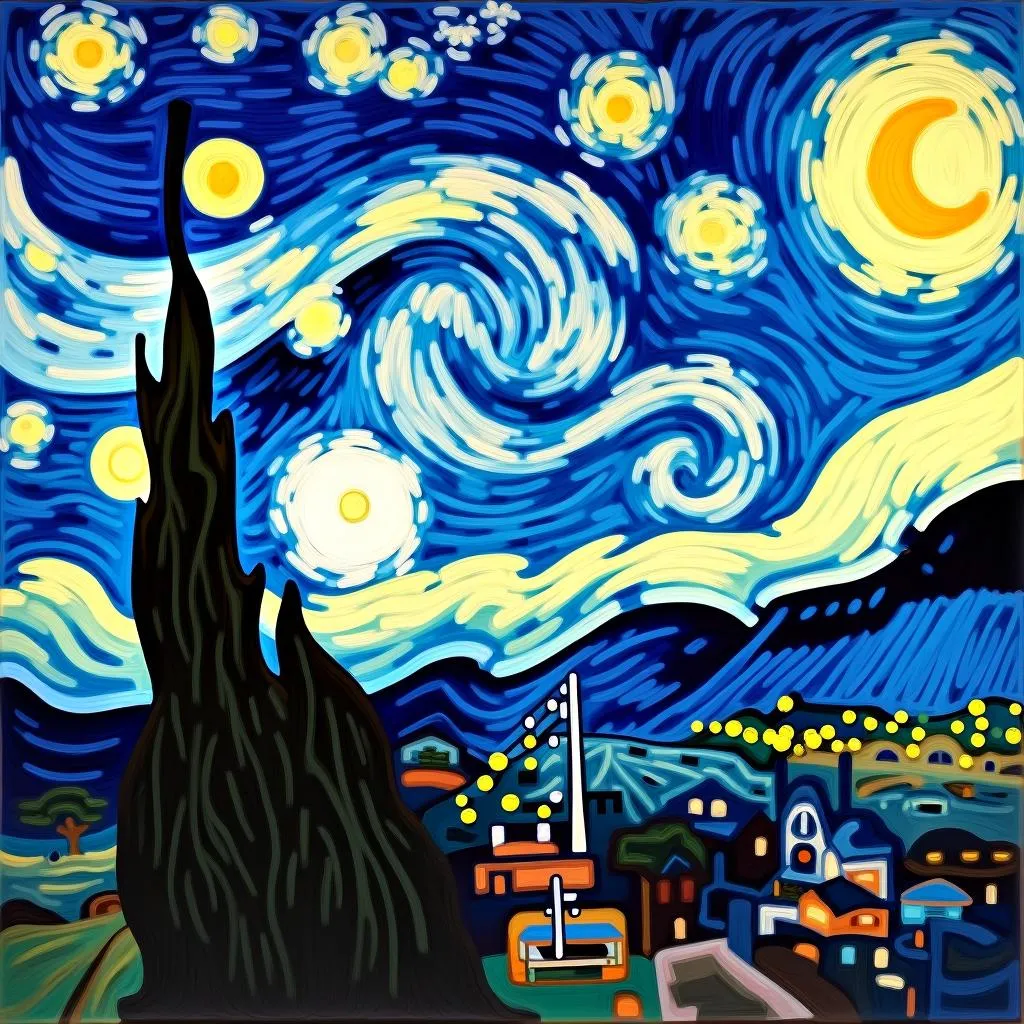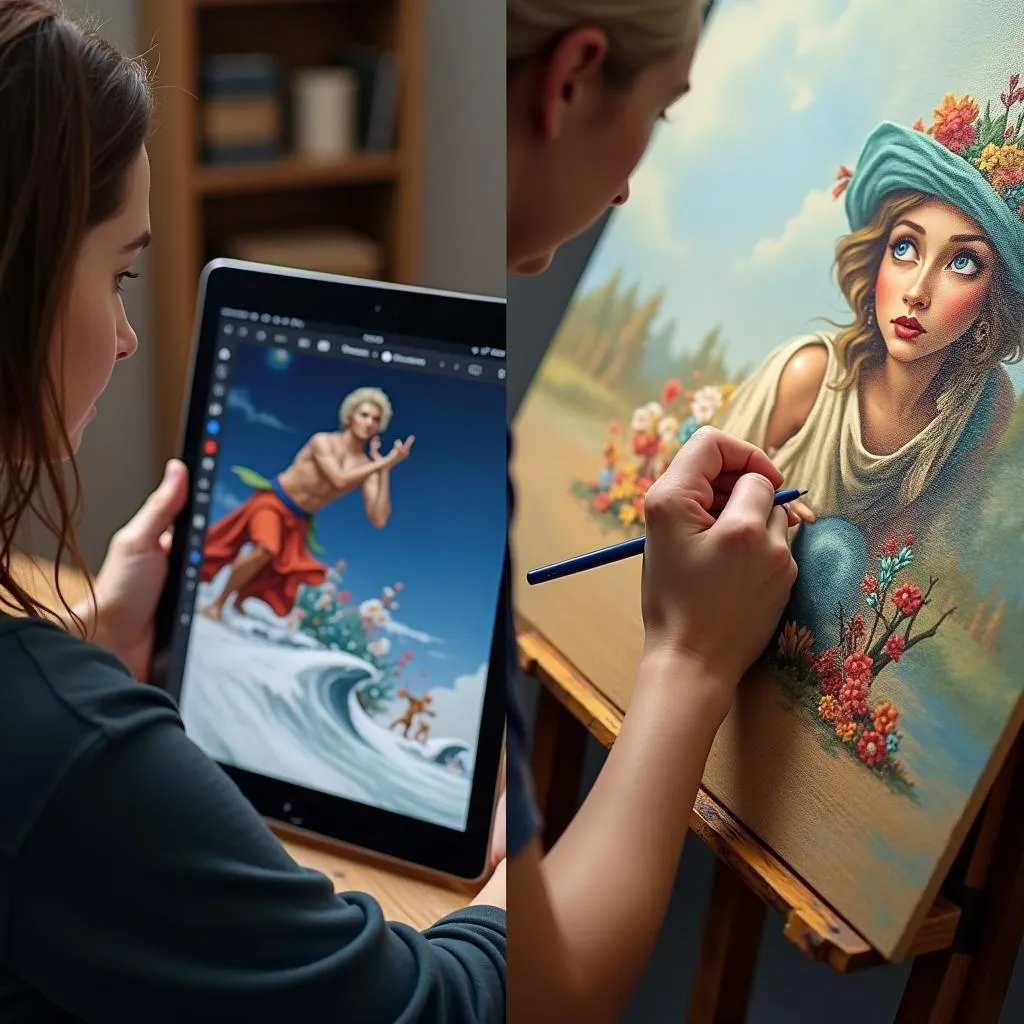Describing a piece of art that inspires you is a common topic in IELTS Speaking tests. This theme allows examiners to assess your ability to express emotions, describe visual elements, and discuss cultural aspects. Let’s explore how to effectively tackle this topic and achieve a high band score.
Part 1: Introduction and Interview
In this section, the examiner may ask general questions about art to warm you up. Here are some potential questions and sample answers:
Do you enjoy visiting art galleries?
Band 6-7 Answer:
Yes, I do. I find art galleries interesting because they expose me to different artistic styles and cultures. I try to visit them whenever I have free time.
Band 8-9 Answer:
Absolutely! I’m quite passionate about exploring art galleries. They serve as windows into diverse cultures and historical periods, allowing me to broaden my perspectives. I make it a point to visit galleries regularly, both in my hometown and when I’m traveling, as I find it tremendously enriching.
What type of art do you prefer?
Band 6-7 Answer:
I’m particularly fond of contemporary art. I like how it often challenges traditional ideas and uses unique materials to express modern concepts.
Band 8-9 Answer:
I’m drawn to a wide range of artistic styles, but I find myself particularly captivated by abstract expressionism. The way artists like Jackson Pollock and Willem de Kooning use color, form, and gesture to convey raw emotion and subconscious thoughts is utterly fascinating to me. It’s a style that really encourages viewers to form their own interpretations, which I find intellectually stimulating.
Describe a natural landscape that you find fascinating is another topic that requires similar descriptive skills. Both topics allow you to showcase your ability to articulate visual elements and personal impressions.
Part 2: Long Turn
In this section, you’ll be given a cue card with a topic and some bullet points. Here’s a sample cue card related to describing an inspiring piece of art:
Cue Card
Describe a piece of art that you find inspiring.
You should say:
- What the artwork is
- Where you saw it
- What it looks like
- And explain why you find it inspiring
Sample Answer (Band 8-9)
The artwork that I find truly inspiring is Vincent van Gogh’s “The Starry Night”. I had the incredible privilege of seeing it in person at the Museum of Modern Art in New York City a few years ago.
This masterpiece is a vibrant oil painting that depicts a night scene in Saint-Rémy-de-Provence, France. The foreground features a village with a prominent church spire, while the background is dominated by a spectacular night sky. What’s particularly striking about this painting is the way Van Gogh portrayed the sky – it’s a swirling mass of blues and yellows, with stars that seem to pulsate with an otherworldly energy.
The cypress tree in the foreground, reaching towards the sky like a dark flame, adds a sense of movement and vitality to the scene. The brushstrokes are bold and expressive, creating a sense of motion and emotion that seems to bring the entire canvas to life.
I find this artwork inspiring for several reasons. Firstly, it’s a testament to the power of individual perception. Van Gogh painted this scene from memory while in an asylum, transforming a simple night view into something magical and transcendent. This reminds me that beauty can be found even in the darkest of times if one chooses to see it.
Secondly, the painting’s emotional intensity is palpable. You can almost feel Van Gogh’s turbulent state of mind in every brushstroke, yet the overall effect is one of beauty rather than despair. This juxtaposition of raw emotion and aesthetic beauty is deeply moving and inspiring to me.
Lastly, “The Starry Night” has become an iconic image in popular culture, demonstrating the enduring power of art to speak to people across generations and cultures. It inspires me to strive for creativity and self-expression in my own life, reminding me that our unique perspectives can touch others in profound ways.
 The Starry Night by Vincent van Gogh
The Starry Night by Vincent van Gogh
Follow-up Questions
- How has this artwork influenced your perspective on art?
Band 8-9 Answer: This masterpiece has profoundly shifted my perspective on art. It’s made me realize that art isn’t just about technical skill or realistic representation, but about conveying emotion and personal vision. Van Gogh’s ability to transform a simple night scene into something so vibrant and emotionally charged has inspired me to look for the extraordinary in everyday scenes. It’s also deepened my appreciation for the power of individual interpretation in art, encouraging me to trust my own creative instincts more.
- Do you think the artist’s personal life influences their work?
Band 8-9 Answer: Absolutely. I believe an artist’s personal experiences and emotional state are intrinsically linked to their creative output. In Van Gogh’s case, his struggles with mental health and his unique way of perceiving the world are clearly reflected in the intense emotions and vibrant colors of “The Starry Night”. This symbiotic relationship between an artist’s life and their work adds depth and authenticity to the art, making it more relatable and powerful. However, it’s also important to note that art can transcend personal circumstances, allowing artists to create beauty and meaning even in challenging times.
Part 3: Two-way Discussion
In this section, the examiner will ask more abstract questions related to the topic. Here are some potential questions and sample answers:
How do you think art impacts society?
Band 6-7 Answer:
Art has a significant impact on society. It can express important ideas, challenge norms, and bring people together. Many artworks have become symbols of cultural movements or historical events.
Band 8-9 Answer:
Art plays a multifaceted and profound role in shaping society. On a cultural level, it serves as a mirror, reflecting the values, concerns, and aspirations of a given time and place. Art can be a powerful catalyst for social change, challenging established norms and bringing marginalized voices to the forefront.
Politically, art has often been used as a form of protest or commentary, with works like Picasso’s “Guernica” becoming iconic symbols of resistance against war and oppression. Economically, the art world can drive tourism, urban development, and creative industries.
Moreover, art has the unique ability to foster empathy and understanding across diverse groups, bridging cultural divides and promoting dialogue. In our increasingly visual digital age, the impact of art on society is perhaps more significant than ever, influencing everything from advertising and design to our daily social media interactions.
Do you think traditional art forms are still relevant in the digital age?
Band 6-7 Answer:
Yes, I believe traditional art forms are still relevant. While digital art is becoming more popular, many people still appreciate the skill and craftsmanship involved in traditional art. Both forms can coexist and complement each other.
Band 8-9 Answer:
Absolutely. While the digital revolution has undoubtedly transformed the art world, traditional art forms remain profoundly relevant in our contemporary context. These time-honored techniques and mediums offer a tangible, sensory experience that digital art often can’t replicate. The texture of a brushstroke, the three-dimensionality of a sculpture, or the delicate lines of an etching provide a visceral connection to the artist’s process that many find irreplaceable.
Moreover, traditional art forms are continuously evolving, often incorporating or responding to digital technologies in innovative ways. This fusion of old and new creates exciting artistic possibilities and dialogues.
Traditional art also plays a crucial role in preserving cultural heritage and techniques that have been refined over centuries. These skills and knowledge bases are invaluable cultural assets that contribute to the rich tapestry of human creativity.
Ultimately, I believe the art world is large enough to embrace both traditional and digital forms. Each has its unique strengths and can inspire and inform the other, leading to a more diverse and vibrant artistic landscape.
 Digital vs Traditional Art Comparison
Digital vs Traditional Art Comparison
Key Vocabulary and Phrases for High Scores
-
Masterpiece /ˈmæstərpiːs/ (noun): An outstanding work of art or craft.
Example: “The Mona Lisa is considered Leonardo da Vinci’s masterpiece.” -
Evocative /ɪˈvɒkətɪv/ (adjective): Bringing strong images, memories, or feelings to mind.
Example: “The painting’s use of color is highly evocative of autumn.” -
Avant-garde /ˌævɒ̃ˈɡɑːd/ (adjective): New and experimental ideas and methods in art, music, or literature.
Example: “Picasso’s cubist works were considered avant-garde in their time.” -
Juxtaposition /ˌdʒʌkstəpəˈzɪʃn/ (noun): The fact of two things being seen or placed close together with contrasting effect.
Example: “The artist’s juxtaposition of vibrant colors and somber themes creates a powerful impact.” -
Ethereal /ɪˈθɪəriəl/ (adjective): Extremely delicate and light in a way that seems not to be of this world.
Example: “The artist’s use of light gives the landscape an ethereal quality.”
Describe a famous building you visited is another topic where these descriptive words and phrases could be useful, especially when discussing architectural features or the building’s aesthetic impact.
Examiner’s Advice
To achieve a high score in the IELTS Speaking test when describing art:
- Use a wide range of vocabulary specific to art and emotions.
- Structure your answer logically, covering all points in the cue card.
- Speak fluently and coherently, using appropriate connecting words.
- Demonstrate your ability to discuss abstract ideas, especially in Part 3.
- Show enthusiasm and personal engagement with the topic.
- Practice describing various artworks to improve your descriptive skills.
Remember, the key to success is not just in knowing about art, but in expressing your thoughts and feelings about it eloquently and engagingly.
Describe an interesting conversation you had with an old person can be another opportunity to showcase your descriptive skills and ability to discuss cultural and historical topics, much like when describing art.


